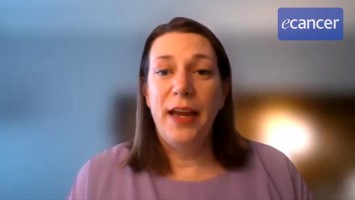The HORIZON trial is a large multi-centre international effort and we today are reporting on 136 patients with relapsed refractory myeloma treated with this very novel targeted cytotoxic called melflufen. Melflufen is actually an alkylator but it’s very special in that it’s activated by aminopeptidases which are enriched in cancer cells. Most importantly it’s lipophilic, its distant parent, melphalan, is lipophobic actually and water soluble whereas this drug is very specifically lipophilic and importantly different. It not only delivers its payload directly to the myeloma through this aminopeptidase mechanism but, by virtue of its effects on the tumour, it has a pleiotropic effect that’s much more dramatic – it’s antiangiogenic, it appears to be retained within the cell, it does remarkable things to the bone architecture in preclinical models. So it has a lot more to it, as it were, than a traditional cytotoxic drug might do.
The important point of it, though, and the reason for its development is it’s targeted. In other words, it’s designed to spare normal tissues and so be delivered very specifically to tumour. In myeloma we show preclinically it’s very active even in melphalan resistant myeloma cells. So in those cells it clearly works and then we’ve been able to show that in other resistant cell lines it’s active.
With that preclinical base we did an early trial called the O-12-M study which was in about 45 patients, all with relapsed refractory disease but more of an earlier phase study determining best dose and schedule. We arrived at 40mg once every four weeks with dexamethasone as being the best way to proceed and that has been the dose that has been taken forward now into more advanced phase studies. So the current phase II HORIZON efforts reflects one of those and there are many other trials ongoing. This trial was really designed to test melflufen dexamethasone in relapsed refractory myeloma in which all three drug classes had failed the patient. So our patients had unfortunately become resistant to proteasome inhibition, to IMiDs and, most importantly, to monoclonal antibodies. So they were highly resistant patients.
In this study what we’ve shown is that this population is actually enriched for what we call extramedullary disease. Now, in the old days, certainly historically, I should say, the incidence in relapsed disease of extramedullary disease was around 10-15%. More recent studies have suggested that this is going up to around 40%. So what we did was we took a hard look at our own patients and have found that the EMD rate is actually very high. Not only is it very high but it’s associated also with an increased rate of what we call high risk cytogenetics. In the study overall over half the patients have high risk cytogenetics. We’ve also found that the amount of extramedullary disease in this population is actually higher than we thought too and around 50% of the patients appear to have significant extramedullary disease. Now, because of that we then looked at how these patients performed in terms of their response characteristics and what we’ve been able to show is that in fact the drug is active in extramedullary disease. Why this is so important is because single agent experiences in extramedullary disease to date have been really quite disappointing. The best data we have, actually, is for daratumumab where in a series of 17 patients the response rate was modest but there, it was around 20%. So in that context we were very pleased to see that in our study we had a response rate of between 20-30% depending on the nature of the extramedullary disease in patients who had had prior daratumumab.
That was the other very important observation of the trial – that if you looked at the patients who had extramedullary disease the majority of them had been exposed previously to monoclonal antibody therapy. So with that in mind, this is a clear area of unmet medical need. We’re using antibodies, they’re great, they’re resulting in fabulous outcomes but the challenge is that when patients relapse, when those drugs fail the patient, we’re then left with a population who have got resistant disease but, not only that, they’re enriched for this extramedullary component. As a result of that we need strategies that can target it. So we think melflufin may constitute an important part of that, based upon the results we’re seeing today.








